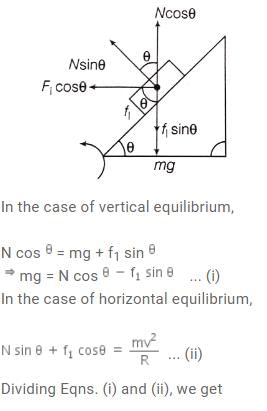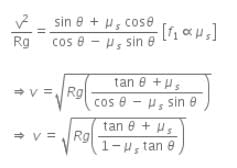Class 11 Exam > Class 11 Questions > A car is negotiating a curved road of radius ...
Start Learning for Free
A car is negotiating a curved road of radius R. The road is banked at angle straight theta. The coefficient of friction between the tyres of the car and the road is straight mu subscript straight s. The maximum safe velocity on this road is,
Verified Answer
A car is negotiating a curved road of radius R. The road is banked at ...
A car is negotiating a curved road of radius R. The road is banked at angle straight theta and the coefficient of friction between the tyres of car and the road is straight mu subscript straight s.
The given situation is illustrated as:



 This question is part of UPSC exam. View all Class 11 courses
This question is part of UPSC exam. View all Class 11 courses
Most Upvoted Answer
A car is negotiating a curved road of radius R. The road is banked at ...
Introduction
When a car negotiates a curved road, several factors come into play to determine the maximum safe velocity. These factors include the radius of the road, the angle of banking, and the coefficient of friction between the car's tires and the road surface.
Centripetal Force and Friction
To understand the maximum safe velocity, we need to consider the forces acting on the car as it goes around the curved road. The centripetal force, provided by the friction between the tires and the road, keeps the car moving in a circular path.
The maximum frictional force that can be exerted between the tires and the road is given by the equation:
Frictional Force (Ff) = Coefficient of Friction (μ) * Normal Force (N)
where the normal force is the force exerted by the road surface on the car, perpendicular to the surface.
The Role of Banking
When the road is banked at an angle, it helps to provide a component of the normal force in the inward direction, reducing the required frictional force. This allows the car to safely negotiate the curve at a higher velocity.
The component of the normal force acting in the inward direction is given by:
Normal Force (N) = Weight of the Car (mg) * cos(θ)
where θ is the angle of banking and m is the mass of the car.
Calculating the Maximum Safe Velocity
To calculate the maximum safe velocity, we need to equate the frictional force to the centripetal force required to keep the car on the curved path. The centripetal force is given by:
Centripetal Force (Fc) = (mass of the car) * (velocity)^2 / Radius of the curve (R)
By equating the frictional force and the centripetal force, we can solve for the maximum safe velocity:
μ * mg * cos(θ) = (m * v^2) / R
Simplifying the equation, we get:
v^2 = μ * g * R * cos(θ)
Taking the square root of both sides, we obtain:
v = √(μ * g * R * cos(θ))
where g is the acceleration due to gravity.
Conclusion
The maximum safe velocity on a curved road depends on the radius of the curve, the angle of banking, and the coefficient of friction between the tires and the road. By considering the forces involved and equating the frictional force to the centripetal force, we can calculate the maximum safe velocity. The angle of banking plays a crucial role in reducing the required frictional force, allowing the car to safely negotiate the curve at a higher velocity.
Attention Class 11 Students!
To make sure you are not studying endlessly, EduRev has designed Class 11 study material, with Structured Courses, Videos, & Test Series. Plus get personalized analysis, doubt solving and improvement plans to achieve a great score in Class 11.

|
Explore Courses for Class 11 exam
|

|
Similar Class 11 Doubts
A car is negotiating a curved road of radius R. The road is banked at angle straight theta. The coefficient of friction between the tyres of the car and the road is straight mu subscript straight s. The maximum safe velocity on this road is,
Question Description
A car is negotiating a curved road of radius R. The road is banked at angle straight theta. The coefficient of friction between the tyres of the car and the road is straight mu subscript straight s. The maximum safe velocity on this road is, for Class 11 2024 is part of Class 11 preparation. The Question and answers have been prepared according to the Class 11 exam syllabus. Information about A car is negotiating a curved road of radius R. The road is banked at angle straight theta. The coefficient of friction between the tyres of the car and the road is straight mu subscript straight s. The maximum safe velocity on this road is, covers all topics & solutions for Class 11 2024 Exam. Find important definitions, questions, meanings, examples, exercises and tests below for A car is negotiating a curved road of radius R. The road is banked at angle straight theta. The coefficient of friction between the tyres of the car and the road is straight mu subscript straight s. The maximum safe velocity on this road is,.
A car is negotiating a curved road of radius R. The road is banked at angle straight theta. The coefficient of friction between the tyres of the car and the road is straight mu subscript straight s. The maximum safe velocity on this road is, for Class 11 2024 is part of Class 11 preparation. The Question and answers have been prepared according to the Class 11 exam syllabus. Information about A car is negotiating a curved road of radius R. The road is banked at angle straight theta. The coefficient of friction between the tyres of the car and the road is straight mu subscript straight s. The maximum safe velocity on this road is, covers all topics & solutions for Class 11 2024 Exam. Find important definitions, questions, meanings, examples, exercises and tests below for A car is negotiating a curved road of radius R. The road is banked at angle straight theta. The coefficient of friction between the tyres of the car and the road is straight mu subscript straight s. The maximum safe velocity on this road is,.
Solutions for A car is negotiating a curved road of radius R. The road is banked at angle straight theta. The coefficient of friction between the tyres of the car and the road is straight mu subscript straight s. The maximum safe velocity on this road is, in English & in Hindi are available as part of our courses for Class 11.
Download more important topics, notes, lectures and mock test series for Class 11 Exam by signing up for free.
Here you can find the meaning of A car is negotiating a curved road of radius R. The road is banked at angle straight theta. The coefficient of friction between the tyres of the car and the road is straight mu subscript straight s. The maximum safe velocity on this road is, defined & explained in the simplest way possible. Besides giving the explanation of
A car is negotiating a curved road of radius R. The road is banked at angle straight theta. The coefficient of friction between the tyres of the car and the road is straight mu subscript straight s. The maximum safe velocity on this road is,, a detailed solution for A car is negotiating a curved road of radius R. The road is banked at angle straight theta. The coefficient of friction between the tyres of the car and the road is straight mu subscript straight s. The maximum safe velocity on this road is, has been provided alongside types of A car is negotiating a curved road of radius R. The road is banked at angle straight theta. The coefficient of friction between the tyres of the car and the road is straight mu subscript straight s. The maximum safe velocity on this road is, theory, EduRev gives you an
ample number of questions to practice A car is negotiating a curved road of radius R. The road is banked at angle straight theta. The coefficient of friction between the tyres of the car and the road is straight mu subscript straight s. The maximum safe velocity on this road is, tests, examples and also practice Class 11 tests.

|
Explore Courses for Class 11 exam
|

|
Suggested Free Tests
Signup for Free!
Signup to see your scores go up within 7 days! Learn & Practice with 1000+ FREE Notes, Videos & Tests.

























